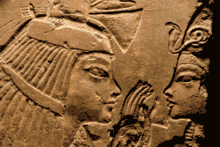Maia (nurse)
| Maia in hieroglyphs |
|---|

Maia was the wet-nurse of the Ancient Egyptian king Tutankhamun. Her rock-cut tomb was discovered in the Saqqara necropolis in 1996.[1][2]
Biography
Maia bears the titles "wet nurse of the king", "educator of the god's body" and "great one of the harem". Nothing is known about her origin, parents and relatives. Tutankhamun is shown sitting on Maia's lap and is also mentioned in the tomb's inscriptions. Among other individuals mentioned in inscriptions are the Overseer of the Magazine Rahotep, the High Priest of Thoth, and scribes named Tetinefer and Ahmose.[3] Zivie has suggested that Maia should be identified with the king's daughter Meritaten.[4]
The tomb
Maia's tomb was discovered in 1996 by the French archaeologist Alain Zivie and his team in the vicinity of the Bubasteion complex dedicated to the deity Bastet at Saqqara. The outside of the tomb is built on limestone with four pillars forming a square. The side walls are decorated with colourful inscriptions that are well preserved. A relief in the tomb's first chamber shows Maia sitting on a chair with Tutankhamun on her lap and surrounded by six persons honouring the young king. A door leads to a second longer chamber full of rubble and partly burnt mummified cats. The second lower level of the tomb was dedicted to Tutankhamun's sister Meritaten.[1]
The tomb contained large amounts of cat mummies and votive objects on a level that had been reused in later periods of the tomb's history. On a lower level, human and cat mummies were found together with statues and sarcophagi. The chapel of the tomb contained a limestone sarcophagus with a cat mummy inside.[2] In 2001, the skeleton of a male lion was found in Meritaten's section of the tomb. It did not have any bandages, but showed signs of mummification similar to other cat mummies found in the tomb.[5] It had probably lived and died in the Ptolemaic period.[6]
The tomb consists of the cult chambers with three decorated rooms and the underground, mostly undecorated, burial chambers. The first room of the cult chapel of her tomb is dedicated to the life of Maia.[7] There is a badly damaged scene showing Maia in front of the king. Only three limestone blocks of this scenes are preserved.[8] The second room is dedicated to the burial rites associated with Maia. Maia is shown in front of offering bearers.[9] She is depicted as a mummy in relation to the opening of the mouth ritual and she is standing before the underworld god Osiris.[10] The third room is the biggest and has four pillars. The pillars are decorated with the image of Maia. The back of the room shows a stela carved into the rock with Maia in front of Osiris.[11] In this room there is also a staircase leading down to the burial chambers. Most other walls of this room are undecorated.
In December 2015 the tomb was re-opened in the presence of Alain Zivie and representatives of the Egyptian Ministry of Antiquities.[12][13]
References
- 1 2 Zivie, A. (1998). "La nourrice royale Maïa et ses voisins: cinq tombeaux du Nouvel Empire récemment découverts à Saqqara". Comptes rendus des séances de l'Académie des Inscriptions et Belles-Lettres. Année 1998 (Janvier−Mars): 33–54.
- 1 2 Zivie, A. and Lichtenberg, R. (2005). "The Cats of the Goddess Bastet". In Ikram, S. Divine Creatures: Animal Mummies in Ancient Egypt. Cairo: American University in Cairo Press. pp. 106–119.
- ↑ Zivie, A.P. (2009). La tombe de Maïa, mère nourricière du roi Toutânkhamon et grande du harem (Bub. I 20). Les tombes du Bubasteion à Saqqara 1. Toulouse: Caracara Édition.
- ↑ Zivie, A. P. (2009). La Tombe de Maia, p. 109−113.
- ↑ Callou, C., Samzun, A. and Zivie, A. (2004). "Le lion du Bubasteion à Saqqara (Égypte)". Nature. 427 (6971): 211–212.
- ↑ Callou, C., Lichtenberg, R., Hennet, P., Samzun, A. and Zivie, A. (2011). "Archaeology: a lion found in the Egyptian tomb of Maia". Anthropozoologica. 46 (2): 63–84.
- ↑ Zivie, La tombe de Maïa, 30-33, pls. 21, 51-55
- ↑ Zivieː La tombe de Maïa, 34, pl. 22-23, 57-60
- ↑ Zivieː La tombe de Maïa, 44-49, pl. 28, 68-71
- ↑ Zivieː La tombe de Maïa, 50-52, pls. 29, 72-73
- ↑ Zivieː La tombe de Maïa, 68-73, pls. 38-41, 83-88
- ↑ Xinhua/Pan Chaoyue, The tomb of Maia to be open to public.
- ↑ Dailymail, Tomb of Tutankhamun's wet nurse is opened for the first time since it was discovered in 1996 accessed 4/27/2017, article shows several photographs of both the interior and exterior of the tomb
External links
- National Geographic: King Tut’s Wet Nurse (Video)
- "Egyptian pharaoh Tutankhamun's wet nurse might have been his sister". The Guardian. 2015.